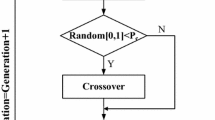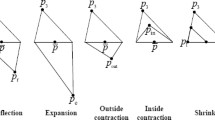Abstract
The paper aims to construct an efficient optimization method for identifying creep and destructuration related governing parameters of soft structured clay. An elastic viscoplastic model has been developed and adopted. Different optimization processes, by genetic algorithm or particle swarm optimization with uniform or random samplings initialization methods, are carried out to obtain the material parameters from conventional undrained triaxial tests performed on a K 0-concolidated natural soft clay. All comparisons demonstrate that the uniqueness of the solution is better guaranteed with the genetic algorithm rather than with the particle swarm optimization method. Furthermore, the efficiency of genetic algorithm has been verified by simulating other tests.
Similar content being viewed by others
References
Biarez, J. and Hicher, P.-Y. (1994). Elementary mechanics of soil behaviour: Saturated remoulded soils, AABalkema.
Calvello, M. and Finno, R. J. (2004). “Selecting parameters to optimize in model calibration by inverse analysis.” Computers and Geotechnics, Vol. 31, No. 5, pp. 410–424, DOI: 10.1016/j.compgeo.2004.03.004.
Eberhart, R. C. and Kennedy, J. (1995). “A new optimizer using particle swarm theory.” In: Proceedings of the sixth international symposium on micro machine and human science, New York, NY, pp. 39–43.
Gens, A., Ledesma, A., and Alonso, E. (1996). “Estimation of parameters in geotechnical backanalysis-II. Application to a tunnel excavation problem.” Computers and Geotechnics, Vol. 18, No. 1, pp. 29–46.
John, H. (1992). Holland, Adaptation in natural and artificial systems, MIT Press, Cambridge, MA.
Javadi, A. A., Rezania, M., and Nezhad, M. M. (2006). “Evaluation of liquefaction induced lateral displacements using genetic programming.” Computers and Geotechnics, Vol. 33, Nos. 4-5, pp. 222–233, DOI: 10.1016/j.compgeo.2006.05.001.
Karstunen, M. and Yin, Z. Y. (2010). “Modelling time-dependent behaviour of Murro test embankment.” Geotechnique, Vol. 60, No. 10, pp. 735–749.
Kennedy, J. and Eberchart, R. C. (1995). “Particle swarm optimization.” Proceedings of the IEEE International Conference on Neural Networks, Perth, Australia, pp. 1942–1948.
Knabe, T., Datcheva, M., Lahmer, T., Cotecchia, F., and Schanz, T. (2013). “Identification of constitutive parameters of soil using an optimization strategy and statistical analysis.” Computers and Geotechnics, Vol. 49, pp. 143–157, DOI: 10.1016/j.compgeo. 2012.10.002.
Lecampion, B., Constantinescu, A., and Nguyen Minh, D. (2002). “Parameter identification for lined tunnels in a viscoplastic medium.” International Journal for Numerical and Analytical Methods in Geomechanics, Vol. 26, No. 12, pp. 1191–1211, DOI: 10.1002/nag.241
Leroueil, S., Kabbaj, M., Tavenas, F., and Bouchard, R. (1985). “Stressstrain-strain-rate relation for the compressibility of sensitive natural clays.” Géotechnique, Vol. 35, No. 2, pp. 159–180.
Levasseur, S., Malécot, Y., Boulon, M., and Flavigny, E. (2008). “Soil parameter identification using a genetic algorithm.” International Journal for Numerical and Analytical Methods in Geomechanics, Vol. 32, No. 2, pp. 189–213, DOI: 10.1002/nag.614.
McKay, M. D., Beckman, R. J., and Conover, W. J. (1979). “Comparison of three methods for selecting values of input variables in the analysis of output from a computer code.” Technometrics, Vol. 21, No. 2, pp. 239–245.
Moreira, N., Miranda, T., Pinheiro, M., Fernandes, P., Dias, D., Costa, L., and Sena-Cruz, J. (2013). “Back analysis of geomechanical parameters in underground works using an Evolution Strategy algorithm.” Tunnelling and Underground Space Technology, Vol. 33, pp. 143–158.
Mostaghim, S. (2004). Multi-objective evolutionary algorithms: Data Structures, Convergence, and Diversity. Shaker.
Pal, S. Wathugala G., and Kundu, S. (1996). “Calibration of a constitutive model using genetic algorithms.” Computers and Geotechnics, Vol. 19, No. 4, pp. 325–348.
Papon, A., Riou, Y., Dano, C., and Hicher, P. Y. (2012). “Single-and multi-objective genetic algorithm optimization for identifying soil parameters.” International Journal for Numerical and Analytical Methods in Geomechanics, Vol. 36, No. 5, pp. 597–618, DOI: 10.1002/nag.1019.
Poles, S., Rigoni, E., and Robic, T. (2004). “MOGA-II performance on noisy optimization problems. In: International Conference on Bioinspired Optimization Methods and their applications.” BIOMA. Ljubljana, Slovena (Oct 2004).
Poloni, C. and Pediroda, V. (1997). “GA coupled with computationally expensive simulations: tools to improve efficiency.” Genetic Algorithms and Evolution Strategies in Engineering and Computer Science, pp. 267–288.
Rechea, C., Levasseur, S., and Finno, R. (2008). “Inverse analysis techniques for parameter identification in simulation of excavation support systems.” Computers and Geotechnics, Vol. 35, No. 3, pp. 331–345, DOI: 10.1016/j.compgeo.2007.08.008.
Reyes-Sierra, M. and Coello, C. C. (2006). “Multi-objective particle swarm optimizers: A survey of the state-of-the-art.” International Journal of Computational Intelligence Research, Vol. 2, No. 3, pp. 287–308.
Rocchi, G., Fontana, M., and Da Part, M. (2003). “Modelling of natural soft clay destruction processes using viscoplasticity theory.” Geotechnique, Vol. 53, No. 8, pp. 729–745.
Rokonuzzaman, M. and Sakai, T. (2010). “Calibration of the parameters for a hardening-softening constitutive model using genetic algorithms.” Computers and Geotechnics, Vol. 37, No. 4, pp. 573–579, DOI: 10.1016/j.compgeo.2010.02.007.
Shen, S.-L., Wu, H.-N., Cui, Y.-J., and Yin, Z.-Y. (2014). “Long-term settlement behaviour of metro tunnels in the soft deposits of Shanghai.” Tunnelling and Underground Space Technology, Vol. 40, pp. 309–323.
Sobol, I. M. (1967). “On the distribution of points in a cube and the approximate evaluation of integrals.” USSR Computational Mathematics and Mathematical Physics, Vol. 7, No. 4, pp. 86–112.
Vardakos, S., Gutierrez, M., and Xia, C. (2012). “Parameter identification in numerical modeling of tunneling using the Differential Evolution Genetic Algorithm (DEGA).” Tunnelling and Underground Space Technology, Vol. 28, pp. 109–123.
Wang, L.-Z. and Yin, Z.-Y. (2012). “Stress dilatancy of natural soft clay under an undrained creep condition.” International Journal of Geomechanics, pp. A4014002, DOI: 10.1061/(ASCE) GM.1943-5622.0000271
Wu, H.-N., Shen, S.-L., Ma, L., Yin, Z.-Y., and Horpibulsuk, S. (2014). “Evaluation of the strength increase of marine clay under staged embankment loading: A case study.” Marine Georesources & Geotechnology, DOI: 10.1080/1064119X.2014.954180
Yin, Z. Y. and Hicher, P. Y. (2008). “Identifying parameters controlling soil delayed behaviour from laboratory and in situ pressuremeter testing.” International Journal for Numerical and Analytical Methods in Geomechanics, Vol. 32, No. 12, pp. 1515–1535.
Yin, Z. Y., Chang, C. S., Karstunen, M., and Hicher, P. Y. (2010). “An anisotropic elastic viscoplastic model for soft clays.” International Journal of Solids and Structures, Vol. 47, No. 5, pp. 665–677, DOI: 10.1016/j.ijsolstr.2009.11.004
Yin, Z. Y., Karstunen, M., Chang, C. S., Koskinen, M., and Lojander, M. (2011). “Modeling time-dependent behavior of soft sensitive clay.” Journal of Geotechnical and Geoenvironmental Engineering, Vol. 137, No. 11, pp. 1103–1113, DOI: 10.1061/(asce)gt.1943-5606.0000527
Yin, Z. Y., Karstunen, M., and Hicher, P. Y. (2010). “Evaluation of the influence of elasto-viscoplastic scaling functions on modelling timedependent behaviour of natural clays.” Soils and Foundations, Vol. 50, No. 2, pp. 203–214, DOI: 10.3208/sandf.50.203.
Yin, Z. Y. and Karstunen, M. (2011). “Modelling strain-rate-dependency of natural soft clays combined with anisotropy and destructuration.” Acta Mechanica Solida Sinica, Vol. 24, No. 3, pp. 216–230.
Yin, Z. Y. and Wang, J. H. (2012). “A one-dimensional strain-rate based model for soft structured clays.” Science China-Technological Sciences, Vol. 55, No. 1, pp. 90–100, DOI: 10.1007/s11431-011-4513-y.
Yin, Z.-Y., Yin, J.-H., and Huang, H.-W. (2015). “Rate-dependent and long-term yield stress and strength of soft wenzhou marine clay: Experiments and modeling.” Marine Georesources & Geotechnology, Vol. 33, No. 1, pp. 79–91.
Yao, Y. P., Lu, D. C., Zhou, A. N., and Zou, B. (2004). “Generalized non-linear strength theory and transformed stress space.” SCIENCE CHINA Technological Sciences, Vol. 47, No. 6, pp. 691–709.
Yao, Y. P., Sun, D. A., and Matsuoka, H. (2008). “A unified constitutive model for both clay and sand with hardening parameter independent on stress path.” Computers and Geotechnics, Vol. 35, No. 2, pp. 210–222.
Yao, Y. P., Hou, W., and Zhou, A. N. (2009). “UH model: three-dimensional unified hardening model for overconsolidated clays.” Geotechnique, Vol. 59, No. 5, pp. 451–469.
Zeng, L. L. (2010). Deformation mechanism and compression model of natural clays, (PHD thesis), Nanjing China, Southeast University.
Zhang, Y., Gallipoli, D., and Augarde, C. (2013). “Parameter identification for elasto-plastic modelling of unsaturated soils from pressuremeter tests by parallel modified particle swarm optimization.” Computers and Geotechnics, Vol. 48, pp. 293–303, DOI: 10.1016/j.compgeo. 2012.08.004.
Author information
Authors and Affiliations
Corresponding author
Rights and permissions
About this article
Cite this article
Jin, YF., Yin, ZY., Riou, Y. et al. Identifying creep and destructuration related soil parameters by optimization methods. KSCE J Civ Eng 21, 1123–1134 (2017). https://doi.org/10.1007/s12205-016-0378-8
Received:
Revised:
Accepted:
Published:
Issue Date:
DOI: https://doi.org/10.1007/s12205-016-0378-8




